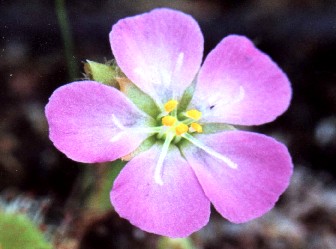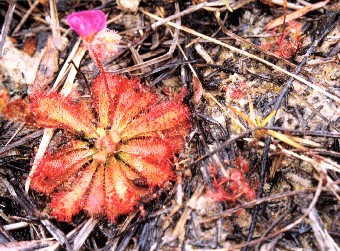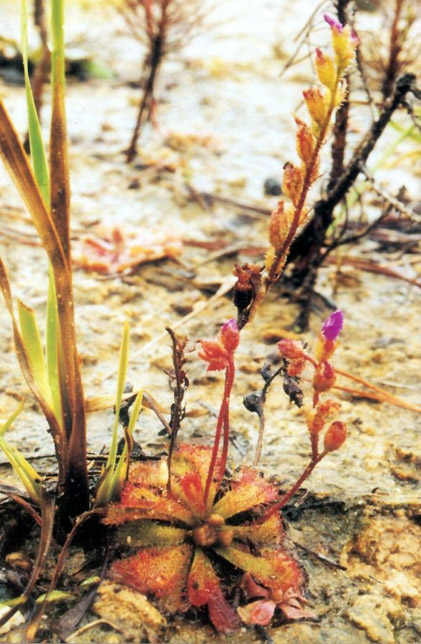|
Carnivorous Plant Newsletter
Volume 34, Number 2, June 2005, pages 56 - 60; Back Cover
Drosera spatulata var. gympiensis: the Formal
Description of the “Hairy Sepal” Taxon from
South-Eastern Queensland
Robert Gibson • New South Wales • Australia
Ivan Snyder • Hermosa Beach, California • USA
Keywords: new taxa, observations: Drosera spatulata, Queensland (Australia).
Introduction
Since the publication of Adrian Slack’s first book in 1980 the world has become aware of morphological variation within Drosera spatulata throughout its geographical range. One novel variant that made a dramatic entrance into the horticultural world has short scapes less than 10 cm tall, which end in a congested raceme of large pink-petalled flowers. The peduncle, pedicels and sepals are conspicuously covered with pilose white hairs. This taxon has informally been known as the “hairy sepal form” and very little has been published about it, particularly its ecological niche. This article is intended to at least partially address this data gap with a formal description of this variant and observations of it in the wild.
Latin Description and Specimens Examined
Drosera spatulata Labill. Var. gympiensis R. Gibson & I. Snyder var. nova.
Affin .D. spatulata Labill., sed inflorescentia breviore, 2-8(13) cm longa, floribus 2-13, pedunculo, pedicellis, et sepalis glanduloso-pilosis.
Holotype: Opposite the south end of Fraser Island, Queensland, in swampy soil; wallam community; sea level, 18 January 1928, Anon. 4 [AQ183256].
Paratype: 25 km NE of Gympie, along Tin Can Bay Road, Queensland, 6 March 2004, R. Gibson & K. Hirsch 130 [BRI, NSW].
Description
Drosera spatulata var. gympiensis differs from the typical form of D. spatulata, with which it grows sympatrically, primarily in scape characters (whose characters, where they differ, are provided in parentheses), in the following ways: Herb with fibrous roots to 0.2 mm diameter. Stem very short. Leaves crowded in a flat rosette 12 to 25 mm diameter; lamina spathulate, narrowed, flat petiole, the whole 5-12 mm long by 2-3 mm wide, the under surface with appressed white eglandular hairs; stipules three-lobed, the central lobe broadly triangular with the free lobe to 1 mm long, the adjacent lobes narrowly triangular, to 3 mm long (see Figure 1, and Back Cover). Inflorescences (0 -) 1-4, racemose, 1-sided, 2-4 (-8) cm long (2-30 cm long) with 3-6 (-13) flowers (2-20 flowers). Peduncle base eglandular pilose with white hairs 0.2 mm long above a sparse cover of white stalked eglandular hairs 0.04 mm long (almost glabrous with scattered glandular hairs to 0.05 mm long); upper peduncle, pedicels and sepals glandular and eglandular pilose with both glandular and eglandular white hairs 0.3-1.0 mm long above a sparse cover of white hairs 0.04 mm long (with a sparse cover of glandular and eglandular hair to 0.05 mm long). Bracts subulate to 1.6 mm long with a few glandular hairs to 0.3 mm long at the base, the remainder of the surface with a moderate cover of white eglandular hairs to 0.04 mm long (subulate to 1.5 mm long, with scattered scabrous eglandular hairs to 0.04 mm long). Pedicels terete 1.2-3.0 mm long (1.2-2.0 mm long). Calyx narrow ovate to narrow obovate, 3.0-3.6 mm long, (elliptic to narrow obovate, 2.0-2.5 mm long). Petals obovate, dark pink, 5 mm long x 3 mm wide (pale pink, 3.2 mm long x 2 mm wide) (see Figure 2). Styles 3, bipartite to the base. Style segments, green to pink, 2-2.5 mm long, terete; the apex rarely bifurcated. Stigmas 0.5 mm long, minutely papillose. Seeds ellipsoid-cylindrical, black 0.4 mm long by 0.1-0.12 mm maximum diameter (black-dark brown, narrow ellipsoid- obovoid, 0.4 mm long by 0.06-0.08 mm maximum diameter). (See Figure 1.)
Distribution
Drosera spatulata var. gympiensis appears to have a limited natural range, found in south eastern Queensland north east of the city of Gympie where one of us (RG) has studied this taxon. The here-designated type specimen was collected about 40 km to the north, but D. spatulata var. gympiensis has not been found around the nearby city of Maryborough (150 km north of Gympie (B. Pierson, pers. comm. March 1999) and to date has not been collected in coastal wetlands south east of Gympie, where it could occur. In contrast the typical form of D. spatulata, informally called the ‘Kanto’ type by Slack (1980), grows sympatrically with D. spatulata var. gympiensis, and is also found along the entire eastern Australian seaboard, and adjacent ranges and throughout Tasmania (Marchant and George, 1982). It also occurs along the western margin of the Pacific Ocean north from New Guinea to southern Japan (Slack, 1980).
Habitat
Drosera spatulata var. gympiensis grows in coastal and near coastal wetlands near the city of Gympie in South Eastern Queensland [26.10˚S; 152.32˚E]. One of us (R.G.) observed this variant in damp clay soil on the edge of a slash pine (Pinus elliottii) plantation and also in heathland along a nearby creek (see Figure 3). The plants were locally abundant in any one area and grew sympatrically with D. burmannii, D. peltata and the typical morphotype of D. spatulata. The two forms of D. spatulata were instantly recognisable and separable by their scapes. The typical taxon has virtually hairless scapes up to 30 cm tall with usually more than ten flowers. No intergrades were observed.
Discussion
The hairy sepal variant has become well known in cultivation over the last 15 years however it is poorly known in the wild. There have been few herbarium collections, of which the oldest I (R.G.) have seen was collected in January 1928 from the mainland Australia coast opposite Fraser Island (Anon. 4 [AQ183256] BRI). This specimen has a short hairy scape with three pink petalled flowers. It was collected in wallam vegetation, a term for coastal heathland in southern Queensland that typically contains species of Banksia (Proteaceae) in the tree and shrub layer. The formal description of Drosera spatulata var. gympiensis is perhaps a bold step. However it appears warranted based on the distinct morphology and genetic isolation of this taxon within this species complex. A formal study of variation within the complex throughout its range is required, and has been given a great start by the detailed cytological work done by Kondo (1971) and by Salmon’s (2001) detailed descriptions of variation within D. spatulata in New Zealand. Salmon described four forms of D. spatulata but noted that intergrades were found between them. No intergrades have been found between D. spatulata var. gympiensis and the typical form of D. spatulata, even though they grow sympatrically. Although, one of us (I.S.) has produced a completely fertile hybrid between these two forms that demonstrates that they are closely related.
Vegetatively Drosera spatulata var. gympiensis is virtually indistinguishable from the typical form of D. spatulata. The flower structure and seed morphology and genetic compatibility are also very close. Given these factors it was considered that varietal status of the “hairy sepal form” was the most appropriate taxonomic status. The formal description of this distinctive taxon is hoped to be an important step in the progressive understanding and analysis of variation within D. spatulata, and may make it possible to consistently apply taxonomic rank to the other members of this complex.
Acknowledgements
I (R.G.) wish to thank the director of The Queensland Herbarium for study access to the collection that provided data for this article. Suggestions from an anonymous reviewer were most appreciated and greatly helped with this paper.
References
Kondo, K. 1971. A Review of the Drosera spatulata complex. Journ. Jap. Bot. 46: 321-326.
Marchant, N. and George A. S. (1982) Droseraceae in (A. S. George Executive Editor) Flora of Australia 8: 9-66. Australian Government Publishing Service, Canberra .
Salmon, B. 2001. Carnivorous Plants of New Zealand. Ecosphere Publications, Manurewa, New Zealand .
Slack, A. 1980. Carnivorous Plants. Alphabooks, Sherborne , England .

Figure 1: Line drawing of Drosera spatulata var. gympiensis. (A) Whole plant in flower showing the thick roots, (B) leaf under-surface showing appressed hairs, (C) leaf upper surface with the stipule pulled back, (D) free portion of the sepal with short and long-stalked glandular hairs, (E) detached petal, (F) open flower, (G) detail of the ovary, styles and stamens--note the rare bifid style apex, (H) bract, (I) ovoid seed and (J1-3) detail of the peduncle surface, J1 = peduncle base, J2 = peduncle below the inflorescence and J3 = peduncle amongst the flowers with a pedicel). Illustration by R. Gibson, June 1999. The scale bar represents 1 mm in all cases. Note the sepal apices in (F) vary in appearance due to the differing degrees that the tips reflex at anthesis. In D. spatulata it is typical for some sepal tips to remain reflexed in fruit.

Figure 2: Close up of the open flower of D. spatulata var. gympiensis in cultivation. Note the dark pink colour of the petals.

Figure 3: Plant of D. spatulata var. gympiensis in the wild, near Gympie. Note the white pilose hairs on the apex of the inflorescence. The sundews to the right are a form of D. peltata. The plants were photographed in early April.

Back Cover: A robust plant of D. spatulata var. gympiensis with the tallest scape seen during fieldwork. Beside it, and behind it are D. burmannii rosettes. Note the clay soil in which the sundews are growing. Photograph by Robert Gibson.
|

